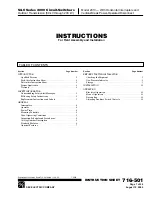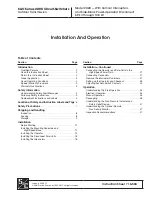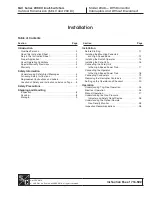
DXS/DWS-3200 series CLI Reference Guide
Page 281
snmp-server engineID local
The
snmp-server engineID local
Global Configuration mode command specifies the Simple Network
Management Protocol (SNMP) engineID on the local device. To remove the configured engine ID, use the
no
form
of this command.
Syntax
snmp-server engineID local
{
engineid-string
|
default
}
no snmp-server engineID local
Parameters
•
engineid-string
—Specifies a character string that identifies the engine ID. (Range: 5-32 characters)
•
default
—The engine ID is created automatically based on the device MAC address.
Default Configuration
The engine ID is not configured.
If SNMPv3 is enabled using this command, and the default is specified, the default engine ID is defined per
standard as:
•
First 4 octets — first bit = 1, the rest is IANA Enterprise number = 674.
•
Fifth octet — set to 3 to indicate the MAC address that follows.
•
Last 6 octets — MAC address of the device.
Command Mode
Global Configuration mode
User Guidelines
To use SNMPv3, you have to specify an engine ID for the device. You can specify your own ID or use a default
string that is generated using the MAC address of the device.
If the SNMPv3 engine ID is deleted or the configuration file is erased, SNMPv3 cannot be used. By default,
SNMPv1/v2 are enabled on the device. SNMPv3 is enabled only by defining the Local Engine ID.
If you want to specify your own ID, you do not have to specify the entire 32-character engine ID if it contains
trailing zeros. Specify only the portion of the engine ID up to the point where just zeros remain in the value. For
example, to configure an engine ID of 123400000000000000000000, you can specify snmp-server engineID local
1234.
Since the engine ID should be unique within an administrative domain, the following is recommended:
For a standalone device, use the default keyword to configure the engine ID.
For a stackable system, configure the engine ID and verify its uniqueness.
Changing the value of the engine ID has the following important side-effect. A user's password (entered on the
command line) is converted to an MD5 or SHA security digest. This digest is based on both the password and the
local engine ID. The user’s command line password is then destroyed, as required by RFC 2274. As a result, the
security digests of SNMPv3 users become invalid if the local value of the engine ID change, and the users will
have to be reconfigured.
You cannot specify an engine ID that consists of all 0x0, all 0xF or 0x000000001.
Summary of Contents for xStack DWS-3200 Series
Page 2: ......
Page 3: ......
Page 25: ...Using the CLI Editing Features Page 22 ...
Page 91: ...Clock Commands show sntp status Page 88 ...
Page 101: ...Configuration and Image File Commands show bootvar Page 98 ...
Page 137: ...GVRP Commands show gvrp error statistics Page 134 ...
Page 147: ...IGMP Snooping Commands show ip igmp snooping groups Page 144 ...
Page 163: ...IP Address Commands show hosts Page 160 ...
Page 177: ...LACP Commands show lacp port channel Page 174 ...
Page 187: ...Line Commands show line Page 184 ...
Page 195: ...Management ACL Commands show management access class Page 192 ...
Page 201: ...PHY Cable Diagnostics Commands show fiber ports optical transceiver Page 198 ...
Page 217: ...Port Monitor Commands Page 214 ...
Page 341: ...Spanning Tree Commands show spanning tree Page 338 ...
Page 395: ...System Management Commands show system mode Page 392 ...
Page 413: ...User Interface Commands show privilege Page 410 ...
Page 437: ...VLAN Commands show vlan protocols groups Page 434 ...
Page 451: ...Web Server Commands show ip https Page 448 ...
Page 477: ...802 1x Commands show dot1x advanced Page 474 ...
Page 483: ...Wireless AP BSS Commands data rates Page 480 ...
Page 517: ...WLAN Domain Commands wlan domain member approve Page 514 ...
Page 547: ...Wireless AP Radio Commands beacon period Page 544 ...
Page 555: ...Wireless Rogue AP Commands show wlan rogue aps neighborhood Page 552 ...
Page 573: ...Wireless WLAN Commands show wlan stations counters Page 570 ...
Page 581: ...Page 578 ...
















































